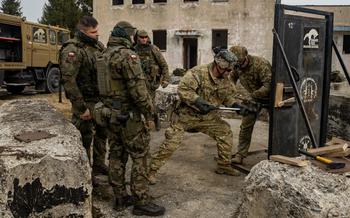U.S. paratroopers assigned to the 3rd Brigade Combat Team, 82nd Airborne Division, and Polish soldiers engage targets during training in Nowa Deba, Poland, March 15, 2022. Poland expects to spend $200 million on upgrades for military bases used by U.S. forces during the next year. (Claudia Nix/U.S. Marine Corps)
STUTTGART, Germany — Poland continues to deliver on in-kind contributions that support the American military presence in the country, with Warsaw in the year ahead expected to spend nearly $200 million on upgrades at bases used by U.S. forces.
The Polish expenditures, detailed in the U.S. Senate’s version of the National Defense Authorization Act for 2025, mark the latest round of initiatives aimed at enhancing the bases.
Last year, Poland agreed to fund $300 million on various projects, including $93 million for ongoing work to build a new Army barracks and a dining facility in Powidz, a major logistical hub for the U.S. military in Poland.
Among allies in Europe, Poland is the only NATO member singled out in the NDAA for making in-kind contributions to the U.S. mission on the Continent.
The projects in Poland are part of a bilateral security agreement that calls for Poland to pick up a large amount of the infrastructure costs needed to support U.S. troops in the country.
The Polish contributions in 2025 include efforts at Lask Air Base, where the U.S. Air Force maintains a steady rotational presence. Construction there adds up to $132 million to support drone and surveillance operations, as well as corresponding taxiway, hangar and communications upgrades needed to support such missions, the NDAA stated.
Separately, Warsaw will spend $56 million on force protection and communications at a base in Wroclaw used for moving U.S. military supplies into Poland.

U.S Army paratroopers assigned to the 3rd Brigade Combat Team, 82nd Airborne Division conduct mechanical breaching training with Polish soldiers in southeastern Poland, March 3, 2022. Poland plans to spend nearly $200 million on upgrades at bases used by U.S. forces across the country in the next year. (Robin Lewis/U.S. Marine Corps)
In recent years, the U.S. has expanded operations in Poland, which has emerged as the center of gravity for missions aimed at deterring Russian aggression on NATO’s eastern flank. In March 2023, the U.S. solidified Poland’s growing status within NATO when the U.S. Army established its first permanent garrison in the country.
While Poland has made no secret about its desire for more U.S. troops, Warsaw also has stood out among NATO members for ramping up expenditures on its own defense.
In 2025, Polish leaders have said the country will increase its defense spending from 4% of gross domestic product to 5%, putting it first among NATO’s 32-member alliance. The U.S. in 2024 dedicated 3.3% of GDP to defense.
While others inside NATO have upped their defense spending, nine of the 32 members still fall short of the alliance’s minimum benchmark, which calls for 2% of GDP to be dedicated to a country’s armed forces.